 |
| Publications |
Summary of Articles in ALERT 2000 In "Its a question of Balance" Maj D P C LEWIS highlights the importance of striking a balance between the competing forces and influences as we seek to make progress. The progress made he points out, comes with a price tag. He declares that "the way forward should be with one leg in the past" or with "one leg on the ground." One of the areas in which we are called on to exercise balance is in our efforts to halt the decadence in the society. Our contribution must be rendered without turning our guns on our brothers and sisters. We are encouraged in the article to "stand on the hard won rights and principles bequeathed by our forefathers," and also to "resist the cynics and make loyalty and dedication more than a punch line." The article appears on page 5 and was adjudged best article.
The article entitled "Drill: a soldiers way of Life" will describe for the reader, the important role that drill plays in the life of military organisations. Mention is made of some drills that members of the public would not have observed. In the article the drill square is described sacred ground and "the shrine to which the soldier goes to mark events of great significance." Drill itself is described as a sacrament which is part of the soldiers way of life. The author Maj O O KHAN answers his own question on the survivability of drill in the technological age with a resounding yes, on the basis that "things sacred are held dear, they die hard and are passed from one generation to the next." The article appears on pages 21 and 52 and was adjudged the second runner up to the best article.
In "Profile of a leader" which appears on page 26, the career of
Major General J I SIMMONDS is charted as he journeyed up the ranks of the officer corps
and through all three infantry battalions to command the Force. A "Rose Among the
Thorns" features Warrant Officer Class II Violyn CAMMOCK who was a member of the very
first intake of female soldiers that enlisted in 1977. The article which appears on page
37 takes a glance at her career in a "man’s domain." "A Tribute to Dad’ is
one of two contributions from civilians this one being done by Mr Robert ROBINSON the son
of the late Brigadier Dunstan ROBINSON, former Chief of Staff. There are several articles which seek to establish the relevance of the
military to contemporary Jamaican society. Capt R JOHNSON tries to aid readers to grasp a The "manner in which the (JDF) may be employed and its operational
command … (are) fundamental to the force…..and must be safeguarded for the
future." This is the considered opinion of Col A G DOUGLAS. While the constitution
makes mention of Coming of Age: The internal security dilemma traces the origins of our
internal security problem and the efforts of law enforcement and the military over the
course of some three decades to come to grips with it. Lt Col SAUNDERS produces published
notes from Don ROBOTHOM, Professor of Anthropology, to show a link
Getting Ready for the Next One by Maj O O KHAN revisits the question of an appropriate training focus in preparation for future operational deployment. The article looks back at past deployments and identifies domestic internal security operations and regional Peace Keeping Operations, as part of a combined Force, as most likely scenarious for deployments in the foreseeable future. The article ends up calling for continued joint training exchanges involving overseas deployments. Consideration of joint training with "selected entities of the United States military" is recommended since there is a strong likelihood that we could be partners in future regional conflicts. Formal joint JDF/JCF awareness training to improve understanding of the social context of the domestic operational environment is also proposed. This article is to be found on pages 13 and 14. There are two articles depicting the training which goes to make a Commissioned Officer. "The making of a Commando" by 2Lt LINTON describes the gruelling training undertaken at the Commando Training Centre Royal Marine in the United Kingdom. "Life as an Officer Cadet" describes training at the more well known Royal Military Academy Sandhurst. This later article is written by Lt T A SPENCE, Lt D O LEWIS and 2LT L G CHEVERRIA. These articles give a good insight into what is involved in basic officer candidate training overseas. They may be found on pages 20 and 42 – 43. The enhanced capabilities of the JDF Air Wing, achieved with the recently acquired helicopters are bourne out in two articles "SAR Birds, The Bell 412EPs of the Jamaica Defence Force" by Lt M BEEK (page 11) and "Thermal Imagery for the 21st Century " by Lt B CREARY (page 18). Readers are apprised in these two articles on the effectiveness of the Bell 412 with its electronic flight instrument system, weather radar, a flight management system and a four axis autopilot system. The Ecureil AS 355N with its capability to capture thermal and colour video images from various distances and also the ability to track targets is aptly described for aviation enthusiasts and all persons interested in knowing about the capabilities of the JDF Air Wing. Sociologist and Environmentalist Peter ESPUET describes the Jamaica Defence Force Coast Guard as an essential national institution in his article that appears on page 19. With Jamaica "an archipelagic state, being composed of five inhabited islands … Jamaica would not be able to monitor or defend its territorial waters without the JDF Coast Guard," so declares Mr. ESPUET. He makes the argument that "if the Coast Guard were provided with the where withal to enforce the fisheries regulations Jamaica could earn more from its fishery resources" and appeals for more resources for the JDF. Previous ALERT articles Click here for articles from the 1998 edition. Articles from the 1996 edition. A Mirror on the
JDF
|
| Copyright
© Jamaica Defence Force, all rights reserved. |
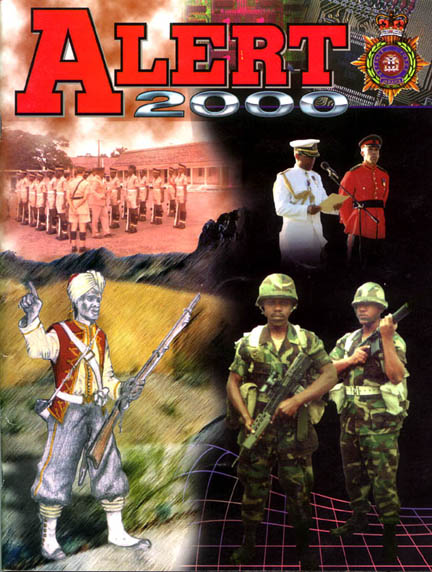
 "From
Fighting Crime to Protecting Communities" was contributed by the Hearts and Minds
team of 1JR that was involved in supporting operation Intrepid Curtail during 1999. The
article speaks of a deliberate shift in the emphasis of the operation from "targeting
criminals to that of protecting the law-abiding residents of the communities."
Several of the activities aimed at having a direct impact on the lives of residents in
order to help "establish a basis for earning legitimacy and the trust of
"From
Fighting Crime to Protecting Communities" was contributed by the Hearts and Minds
team of 1JR that was involved in supporting operation Intrepid Curtail during 1999. The
article speaks of a deliberate shift in the emphasis of the operation from "targeting
criminals to that of protecting the law-abiding residents of the communities."
Several of the activities aimed at having a direct impact on the lives of residents in
order to help "establish a basis for earning legitimacy and the trust of the communities" are
reported. The article shows how the hard core security functions such as patrolling were
executed in a manner designed to enhance the sense of security and contribute to the
social development of the most vulnerable communities that had been selected to house
operational bases. This article appears on page 32 and 33 and was adjudged the runner up
best article.
the communities" are
reported. The article shows how the hard core security functions such as patrolling were
executed in a manner designed to enhance the sense of security and contribute to the
social development of the most vulnerable communities that had been selected to house
operational bases. This article appears on page 32 and 33 and was adjudged the runner up
best article.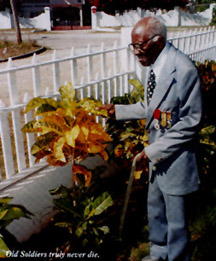 There are four articles that feature personalities. Mr Eugent CLARKE is the
subject of the article entitled Verteran Extraordinaire that appears on page 6. Mr. CLARKE
is one of the old soldiers that never dies but only fades away. At age 105 years he is
acclaimed as the oldest known Jamaican verteran of World War 1. If any reader is aware of
a challenger to that claim then please come forward. Mr. CLARKE was the recipient of
France’s highest award, the Legion of Honour, in commemoration of his participation in the
war. The article relates some of the experiences of Mr. CLARKE, just prior to, during and
immediately after the Great War.
There are four articles that feature personalities. Mr Eugent CLARKE is the
subject of the article entitled Verteran Extraordinaire that appears on page 6. Mr. CLARKE
is one of the old soldiers that never dies but only fades away. At age 105 years he is
acclaimed as the oldest known Jamaican verteran of World War 1. If any reader is aware of
a challenger to that claim then please come forward. Mr. CLARKE was the recipient of
France’s highest award, the Legion of Honour, in commemoration of his participation in the
war. The article relates some of the experiences of Mr. CLARKE, just prior to, during and
immediately after the Great War.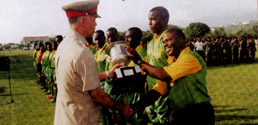 The article
appears on page 41 along with photography of the late Brigadier. Readers are offered
snapshots of the life of Brigadier ROBINSON that will bring back memories to those who
served with the distinguished gentleman. Those who never served with him will come to
appreciate his legacy and why he is considered to be legendary by many.
The article
appears on page 41 along with photography of the late Brigadier. Readers are offered
snapshots of the life of Brigadier ROBINSON that will bring back memories to those who
served with the distinguished gentleman. Those who never served with him will come to
appreciate his legacy and why he is considered to be legendary by many.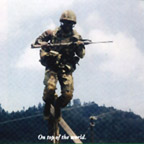 basic understanding of the
profession of arms. He draws on the writings of noted sociologist Samuel HUNTINGTON to lay
out criteria on which an area of specialty may be described as a profession. These
criteria are named as expertise, responsibility and corporateness. He also makes reference
to Gen HACKETT who regards professionalism more in terms of functions performed. Capt
JOHNSON maintains that the nature of the functions the military may be called upon to
perform may be subject to change from time to time but, that the military should not cause
its distinctive professional expertise to change. Read his article on page 7.
basic understanding of the
profession of arms. He draws on the writings of noted sociologist Samuel HUNTINGTON to lay
out criteria on which an area of specialty may be described as a profession. These
criteria are named as expertise, responsibility and corporateness. He also makes reference
to Gen HACKETT who regards professionalism more in terms of functions performed. Capt
JOHNSON maintains that the nature of the functions the military may be called upon to
perform may be subject to change from time to time but, that the military should not cause
its distinctive professional expertise to change. Read his article on page 7. the military, the author articulates the position that the JDF
is one of those institutions that warrants the protection and preservation of the
constitution, based on its inherent and permanent value to the nation. A carefully
researched article that should be read by all persons interested in the preservation of
national institutions in particular the military. Read "The JDF and Constitutional
Reform" found on pages 9 and 10.
the military, the author articulates the position that the JDF
is one of those institutions that warrants the protection and preservation of the
constitution, based on its inherent and permanent value to the nation. A carefully
researched article that should be read by all persons interested in the preservation of
national institutions in particular the military. Read "The JDF and Constitutional
Reform" found on pages 9 and 10. between youth unemployment and
crime. The article presents an analysis of the Joint Operations concept applied over the
period, highlighting the effects on the military and the police, as well as presenting a
public perspective. Possible solutions are proposed which include a call for military
deployment to be "curtailed to those situations where it is clear that it is not (a
situation) with which the police is capable of dealing." The major elements of the
recommended solution are education, relevant job creation, and physical upgrading of
inner-city infrastructure. The article is spread over pages 27, 28 and 44.
between youth unemployment and
crime. The article presents an analysis of the Joint Operations concept applied over the
period, highlighting the effects on the military and the police, as well as presenting a
public perspective. Possible solutions are proposed which include a call for military
deployment to be "curtailed to those situations where it is clear that it is not (a
situation) with which the police is capable of dealing." The major elements of the
recommended solution are education, relevant job creation, and physical upgrading of
inner-city infrastructure. The article is spread over pages 27, 28 and 44.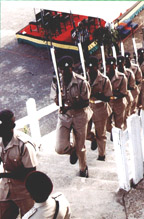 Keeping in step by Lt Col A V CARTER calls for a re-examination of the
prevailing military culture of command and control. He argues that such a culture has to
be "tempered with a culture of empowerment." There is a call for the realization
that the survival of the organisation depends on the day to day mobilization of every
ounce of intelligence available. To achieve this and keep in step with contemporary
society the author calls for greater expenditure on non-military training. Read this
article on page 12.
Keeping in step by Lt Col A V CARTER calls for a re-examination of the
prevailing military culture of command and control. He argues that such a culture has to
be "tempered with a culture of empowerment." There is a call for the realization
that the survival of the organisation depends on the day to day mobilization of every
ounce of intelligence available. To achieve this and keep in step with contemporary
society the author calls for greater expenditure on non-military training. Read this
article on page 12.